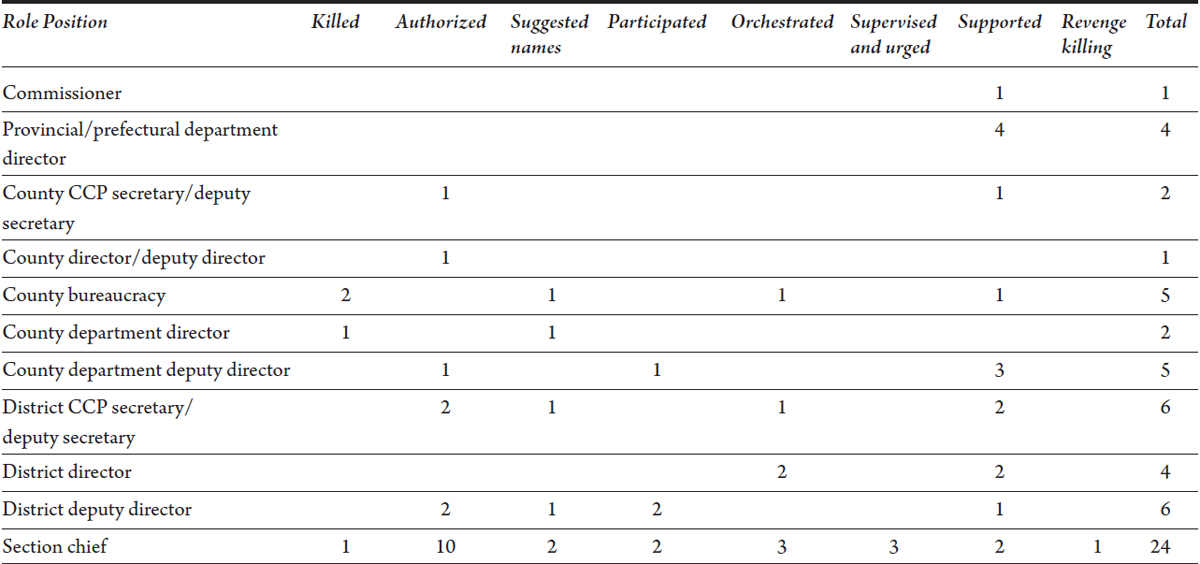

I have in my possession a report submitted to the Lingling prefectural Chinese Communist Party (CCP) committee by the Task Force, which I at one point excised from the book on the advice of some comrades. There were a number of reasons for this, including requirements relating to publication, the need to protect people who had provided information, and the wish to preserve stability and unity, but the fundamental reason was that it was too shocking and subversive. In the course of the current revision, I decided to restore it for the sake of posterity.
Before quoting this report, I took the precaution of giving it to Liu Xianxi, who paid a heavy price for his participation in the 1968 “exposure study sessions” on the Daoxian killings. After reading this report, Liu said, “The actual situation was much more serious than this. The lid was never truly lifted off the Daoxian killings. In particular, this report doesn’t touch on the PAFD [People’s Armed Forces Department] cadres involved, and without bringing them into it, it’s impossible to uncover the truth of the Daoxian killings. During the 1968 ‘exposure study sessions,’ He Xia, Zhang Mingchi, and others wrote confessions that pinpointed several PAFD commanders and a small number of county party committee leaders. In particular, [county PAFD political commissar] Liu Shibin circulated reports on the enemy situation at every meeting and incited killings. [County PAFD commander] Cui Baoshu deceived his superiors and pressured his subordinates, lying about the situation and hiding the truth of the killings from the 47th Army and the provincial Cultural Revolution Committee. There was also a deputy political commissar, Qiu Qinglong, who was very substandard and sloppy, and he spoke a lot of nonsense. PAFD military affairs section head Zhou XX and logistics section head Liu XX, who assumed command of the Red Alliance’s Yingjiang headquarters, were very problematic. … These people all bear an inescapable responsibility for the Daoxian massacre. None of them is named in this report, and that is manifestly unfair to those who are named. The reason these people weren’t investigated and punished was because they were in military uniform. I’ve never been able to understand why people who committed errors while wearing a blue Mao suit could be pursued, but not those wearing yellow military uniforms.”
Following are excerpts from the Task Force report:
Some Circumstances Relating to Cadres Implicated in the “Killing Wind”
There are many people implicated in the “killing wind”; state cadres alone number 215 (the actual number is in fact much greater). Among the 150 people who have been investigated, 95 are cadres of the level of commune deputy director or above, including 25 reporting directly to the prefectural level or above.
Cadres had three main types of involvement in the killing wind:
First, they incited and orchestrated the killings, personally proposed names, and authorized and mobilized killings. These people included 188 state cadres, of whom 78 were at the level of commune deputy director or above (including 10 reporting directly to the prefectural level or above). The most problematic of these include:
[Thirteen cadres are listed, with details of their participation as narrated in this book.]
Second, they took arbitrary stands sympathizing with and supporting the killings. Preliminary information indicates that such people included 27 state cadres, 20 of whom are currently cadres of commune vice director or above (and 11 reporting directly to the prefectural level or above), in particular the following:
[Six cadres are listed, with details of their participation.]
Third, preliminary information indicates 25 cases of killings for the purpose of personal revenge or to obtain the assets or wives of others.
According to preliminary information, 90 cadres at the level of commune deputy director or above are implicated in the “killing wind,” including:
(1)Five who killed with their own hands;
(2)Twenty-nine who authorized killings or specified persons to be killed;
(3)Eight who participated in discussions about killings;
(4)Fifteen who mobilized killings;
(5)Eight who supervised or urged killings;
(6)Twenty-five who took a stand in support of killings.


| Formerly reporting to the prefecture or above | Currently reporting to the prefecture or above | |
| Killed | 1 | 3 |
| Authorized killings | 4 | 4 |
| Proposed names | 1 | 3 |
| Sympathized with or supported | 7 | 11 |
| Participated or arranged | 1 | |
| Total | 13 | 25 |
Name list:
Sympathized with or supported killings: Xiong Bing’en, Yu Shan, Wang Ansheng, He Rongyu, Li Mingde, Zhu Guangrong, Xiao Fuzhi, Zhang Renda
Authorized killings: Li Laiwen, Zheng Jitian, Yang Junxian
Proposed victims: Wu Ronggao
Killed: Ou Caiqing